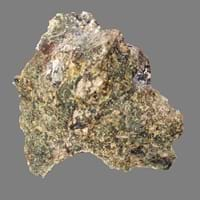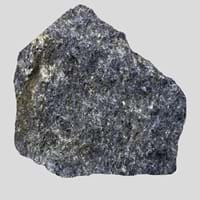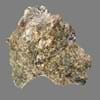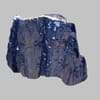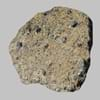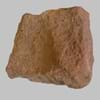Definition
Harzburgite is a plutonic rock of the peridotite group consisting largely of orthopyroxene and olivine
Blueschist is a metamorphic rock which is generally blue in color and is formed under conditions of high pressure and low temperature
Discoverer
Unknown
Edgar Bailey
Etymology
From the name of a town in Harzburg, Germany
From French schiste, Greek skhistos i.e. split
Class
Igneous Rocks
Metamorphic Rocks
Sub-Class
Durable Rock, Medium Hardness Rock
Durable Rock, Medium Hardness Rock
Group
Plutonic
Not Applicable
Other Categories
Coarse Grained Rock, Opaque Rock
Fine Grained Rock, Medium Grained Rock, Opaque Rock
Texture
Phaneritic
Foliated
Color
Dark Greenish - Grey
Blue, Bluish - Grey, Purple, Shades of Blue
Durability
Durable
Durable
Appearance
Rough and Shiny
Dull and Banded
Interior Uses
Decorative Aggregates, Homes, Interior Decoration
Floor Tiles, Flooring, Homes, Hotels, Kitchens
Exterior Uses
As Building Stone, As Facing Stone, Garden Decoration, Office Buildings, Paving Stone
Garden Decoration, Office Buildings
Other Architectural Uses
Curbing
Not Yet Used
Construction Industry
As Dimension Stone, Cobblestones
As Dimension Stone, Cobblestones, Rail Track Ballast, Roadstone
Medical Industry
Not Yet Used
Not Yet Used
Antiquity Uses
Artifacts, Monuments, Sculpture, Small Figurines
Artifacts, Monuments, Sculpture
Commercial Uses
Creating Artwork, Gemstone, Jewelry, Source of Chromite, Platinum, Nickel and Garnet, Source of Diamonds
Cemetery Markers, Commemorative Tablets, Creating Artwork, Curling, Tombstones
Types
Not Available
Not Available
Features
Constitutes upper part of the Earth's mantle, Generally rough to touch, Is one of the oldest rock
Has High structural resistance against erosion and climate, Very fine grained rock
Archaeological Significance
Famous Monuments
Data Not Available
Data Not Available
Famous Sculptures
Data Not Available
Data Not Available
Formation
Harzburgite is a fine-grained, hard rock which is a type of metasomatite, essentially altered basalt. It forms with or without crystallization, either below the surface as intrusive rocks or on the surface as extrusive rocks.
Blueschist forms due to the metamorphism of basalt and other rocks with similar composition at high pressures and low temperatures and approximately corresponding to a depth of 15 to 30 kilometers and 200 to 500 °C.
Mineral Content
Amphibole, Chromite, Garnet, Magnesium, Olivine, Phlogopite, Plagioclase, Pyroxene
Albite, Chlorite, Epidote, Garnet, Glaucophane, Lawsonite, Muscovite or Illite, Quartz
Compound Content
Ca, Fe, Mg, Potassium, Silicon Dioxide, Sodium, Titanium Dioxide
Aluminium Oxide, CaO, Iron(III) Oxide, FeO, Potassium Oxide, MgO, MnO, Sodium Oxide, Phosphorus Pentoxide, Silicon Dioxide, Titanium Dioxide
Types of Metamorphism
Impact Metamorphism
Not Applicable
Types of Weathering
Chemical Weathering, Mechanical Weathering
Mechanical Weathering
Types of Erosion
Chemical Erosion, Sea Erosion
Chemical Erosion, Coastal Erosion, Water Erosion, Wind Erosion
Grain Size
Coarse Grained
Fine to Medium Grained
Fracture
Irregular
Conchoidal
Streak
White
White to Grey
Porosity
Less Porous
Highly Porous
Specific Gravity
3-3.01
3-3.2
Transparency
Translucent to Opaque
Opaque
Density
3.1-3.4 g/cm3
2.8-2.9 g/cm3
Specific Heat Capacity
Not Available
Resistance
Heat Resistant, Pressure Resistant, Wear Resistant
Impact Resistant, Pressure Resistant
Deposits in Eastern Continents
Asia
Japan, Oman
Japan, Turkey
Africa
South Africa
Egypt, Ethiopia, South Africa
Europe
France, Germany, Italy, Venezuela
France, Greece, Iceland
Others
Hawaii Islands, Mid-Atlantic Ridge
Not Yet Found
Deposits in Western Continents
North America
Canada, USA
USA
South America
Not Yet Found
Not Yet Found
Deposits in Oceania Continent
Australia
Not Yet Found
New Zealand
Harzburgite vs Blueschist Characteristics
Though some rocks look identical, they have certain characteristics which distinguish them from others. Characteristics of rocks include texture, appearance, color, fracture, streak, hardness etc. Harzburgite vs Blueschist characteristics assist us to distinguish and recognize rocks. Also you can check about Properties of Harzburgite and Properties of Blueschist. Learn more about Harzburgite vs Blueschist in the next section. The interior uses of Harzburgite include Decorative aggregates, Homes and Interior decoration whereas the interior uses of Blueschist include Floor tiles, Flooring, Homes, Hotels and Kitchens. Due to some exceptional properties of Harzburgite and Blueschist, they have various applications in construction industry. The uses of Harzburgite in construction industry include As dimension stone, Cobblestones and that of Blueschist include As dimension stone, Cobblestones, Rail track ballast, Roadstone.
More about Harzburgite and Blueschist
Here you can know more about Harzburgite and Blueschist. The life cycle of a rock consists of formation of rock, composition of rock and transformation of rock. The composition of Harzburgite and Blueschist consists of mineral content and compound content. The mineral content of Harzburgite includes Amphibole, Chromite, Garnet, Magnesium, Olivine, Phlogopite, Plagioclase, Pyroxene and mineral content of Blueschist includes Albite, Chlorite, Epidote, Garnet, Glaucophane, Lawsonite, Muscovite or Illite, Quartz. You can also check out the list of all Igneous Rocks. When we have to compare Harzburgite vs Blueschist, the texture, color and appearance plays an important role in determining the type of rock. Harzburgite is available in dark greenish - grey colors whereas, Blueschist is available in blue, bluish - grey, purple, shades of blue colors. Appearance of Harzburgite is Rough and Shiny and that of Blueschist is Dull and Banded. Properties of rock is another aspect for Harzburgite vs Blueschist. The hardness of Harzburgite is 5.5-6 and that of Blueschist is 3.5-4. The types of Harzburgite are Not Available whereas types of Blueschist are Not Available. Streak of rock is the color of powder produced when it is dragged across an unweathered surface. The streak of Harzburgite is white while that of Blueschist is white to grey. The specific heat capacity of Harzburgite is 1.25 kJ/Kg K and that of Blueschist is Not Available. Depending on the properties like hardness, toughness, specific heat capacity, porosity etc., rocks are resistant to heat, wear, impact, etc.Harzburgite is heat resistant, pressure resistant, wear resistant whereas Blueschist is impact resistant, pressure resistant.
